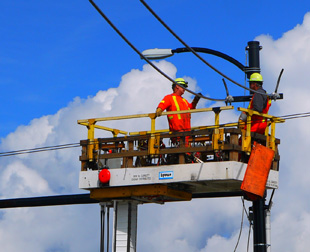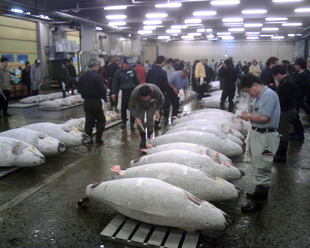
Light Bulb Change by Committee
With just over a year left until the Ontario Solar Feed-In-Tariff (FIT) program expires, there were two significant announcements yesterday that have significant implications for how the program operates.
While that news was breaking, however, there has been no update on how many of the approximately 11,000 pending solar ground-mount applications affected by the recent tariff cut had re-applied by the September 2 deadline nor where they stand in the approval queue.
microFIT Advisory Panel Formed, FIT Advisory Panel Forming
The first piece of news yesterday came from the Ontario Power Authority (OPA), who announced that the previously announced microFIT Advisory Panel has now been formed – and that a similar panel is being formed for the FIT program. The twenty-one Advisory Panel members include representatives from the OPA and Ministry of Energy and Infrastructure (MEI) as well as utilities Hydro One, Chatham-Kent Hydro and PowerStream. The bulk of the Advisory Panel membership is dominated by various industry associations, such as the Canadian Solar Industries Association (CanSIA), and special interest groups. There are no members on the Advisory Panel from any commercial participants or suppliers.
Two of the top three “priority items” for the new Advisory Panel include defining what a ‘Commercial Aggregator’ is and what their procurement approach can be. These priority items come as something of a surprise and suggest that the FIT Program is still operating in reactionary mode.
The term ‘Commercial Aggregator’ was first introduced by the OPA just a month ago, on August 13, with the finalization of the surprise rate cut for ground-mount solar MicroFIT (under 10 kW) projects. While the OPA did concede to extensive industry pressure and reduce the tariff cut from 27% to 20%, they announced that they microFIT program would now exclude what were described as Commercial Aggregators. The OPA defined Commercial Aggregators as “businesses that lease land or rooftops from individuals for multiple renewable energy projects”.
A d-bits article at the time was one of the more outspoken commentaries on the potential implications of this new microFIT program restriction and exclusion, underscoring that:
“The exclusion of Commercial Aggregators from participation in the Ontario PV market … directly impacts the number and type of jobs that will be created, as well as access to the program by individual residents who may require their assistance. If Commercial Aggregators make it easier for MicroFIT applicants to take advantage of the FIT program, they would fundamentally catalyze market acceptance of the FIT Program and benefit participating Ontario residents directly.”
Notably, one of the members of the new Advisory Panel, the OPA-enabled and endorsed Community Power Fund, arguably provides a form of ‘Aggregator’ type facilitation services – albeit as a non-profit entity.
It will be interesting to see how the new Advisory Panel deals with potential program facilitators such as Commercial Aggregators.
Japan Launches Domestic Content Complaint with WTO

Tuna Auction at Tokyo Fish Market
The second piece of news yesterday had arguably even more profound implications for the Ontario Solar FIT and microFIT programs. An AFP article advised that the Japanese Government announced that it had launched a formal complaint with the World Trade Organization (WTO). The Japanese Government allegedly argued that the Ontario Solar FIT Program’s Domestic Content requirements “violates WTO rules and is protectionist.” Moreover, according to the article, should “the next round of negotiations fail, Japan will likely ask the WTO to set up a panel for dispute settlement.”
This concern and complaint from Japan should not come as a surprise. The Japanese solar manufacturers Sharp, Kyocera, Sanyo and Mitsubishi Electric are some of the largest producers in the industry. They have been active in Canada for years if not decades, have partnered with a number of local Ontario firms pursuing FIT projects, and have been actively restricted from participation in the Feed-In-Tariff program by the current structure of the Domestic Content requirements.
Whatever the outcome of the WTO complaint, this initiative is going to require a lot more time, effort and money on the part of the OPA and the MEI. Though not yet listed as one of their priority item, it will likely consume a lot of attention from the newly formed Advisory Panel as well.
Domestic Content Interpretation Process
Unfortunately, the OPA does not appear to be making its unique Domestic Content provisions any easier to manage. Since first announced, there have been three different strategies on Domestic Content compliance pursued within the solar industry:
- Companies who announced intentions to establish operations in Ontario or work with already established local entities
- Companies actively monitoring the program development to determine how the Domestic Content implementation would unfold
- Companies who launched efforts to overturn or reduce the impact of the provisions
Some companies may have pursued more than one of these strategies.
Back in February this year, after extensive industry feedback, the OPA laid out a plan for ‘interpretations’ on its Domestic Content policy. In so doing, they outlined seven areas that were scheduled for public comment, review and implementation. There has been modest progress against that OPA announced plan, however. The review process is now months behind, and at least four of the initially proposed interpretation areas have yet to be posted for review. It is quite possible that a number of the amendments that would have resulted from this review process would have mitigated the building tensions over Domestic Content requirements.
While VP Business Development at 6N Silicon, I submitted a proposed clarification in October 2009 – shortly after the September 29 program launch – for Ontario domestically produced polysilicon (solar grade purified silicon feedstock). As a domestic producer with considerable capacity, 6N Silicon arguably stood to benefit directly from the Domestic Content provisions. Yet that submission was prompted to reaffirm that standard industry manufacturing practices would be Domestic Content compliant and thus allow domestically produced products to receive Domestic Content credit. Even as a widely acknowledged beneficiary of the Domestic Content provisions, it appeared necessary to have those provisions clarified.
Though I no longer have a vested interest in adoption of that proposed clarification, I still strongly believe that this proposal on domestically produced silicon is in the best interests of the FIT program and its many participants directly and indirectly. That proposal will not resolve all disputes and concerns, of course, and may yet benefit from refinement by the OPA and MEI as well as from the public comment and review process. Fundamentally, though, pro-active attention to resolving Domestic Content issues is critical to the success of the Ontario Feed-In-Tariff program.
Urgent attention to industry feedback on domestically produced silicon and other Domestic Content areas could go a long way to facilitating a healthy Ontario Solar industry that creates and preserves green energy jobs. Without explicit and timely management, we may see yet more industry concern, complaint and protest.
Previous d-bits posts on the Ontario Solar PV FIT and MicroFIT programs:
- Reactions to Ontario’s Solar FIT Program Changes
- Concessions and New Restrictions for Ontario’s Solar FIT Program
- Update on Ontario PV Ground-Mount Tariff Changes
- Comparing PV Feed-In-Tariff Programs from Ontario and Germany
- Ontario’s Growing Pains: Will the Wind and Solar Industries Scale-up in Time?
- PHOTON Magazine Says Ontario Guides the Way
- Ontario FIT Program Changes Generate Controversy amid Compliance
- Ontario FIT Program: Definitions are Changing
- Ontario Power Authority Announces Change on Short Notice
- The Feed In Tariff is Energizing Ontario
- Ontario Domestic Content




No Responses to “Ontario microFIT Advisory Panel formed, Japan Challenges Solar Domestic Content”
Trackbacks/Pingbacks